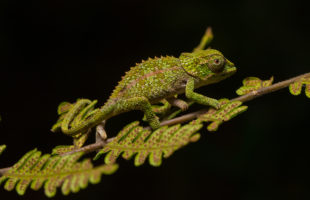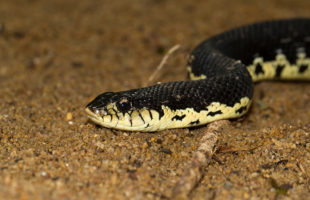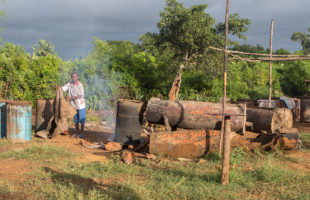Amber Mountain: The name comes from the flowers of certain trees that cover the mountain and shine amber from afar. Location: The Amber Mountain National Park is located in northwestern Madagascar in the Diana region. The nearest major city is Antsiranana (Diego Suarez) on the coast, about 30 km away. From the capital Antananarivo, the park is located about 1000 …
LesenMasika sipa
Saha Maintsoanala
Saha Maintosanala: The word “Saha” means a park, and Maintsoanala means “green forest”. The protected area is simply called the “Park of the green forest”. Location: The reserve is located only 65 km from Antananarivo near the small town of Mandraka in the Analamanga region. The journey on the winding roads of the eastern highlands takes about two hours by …
LesenThe gardeners of the forest: Red-bellied lemurs
One does not often meet red-bellied lemurs (Eulemur rubriventer) in Madagascar, but they play an important role in the rainforest’s fragile ecosystem. Only male wear the eponymic red belly, females are white or cream colored on chest and belly. Males also have white fur below their eyes which lacks in females. At average, red-bellied lemurs weigh one and a half …
LesenThe best travel season
Madagascar has the perfect travel time for everyone, but it is not the same time of year for everyone. Because it all depends on what you want to see! If you want to see Madagascar’s mascot, the lemurs, you should come to Madagascar at the end of the dry season. The best time to observe lemurs is September and October. …
LesenMora mora – Take it easy
Hectic, stress and urgent appointments: In Madagascar you can leave all this behind you. Time is of no use here outside the cities. “Mora mora” is often the first thing you hear as a traveller in Madagascar – often at the visa counter. It means “slow, slow” or “take it easy” and reflects briefly and concisely the attitude to life …
LesenAn east-west-conflict: Red-fronted lemurs
In red-fronted lemurs, colour has been distributed inequally: Only males bear the eponymic red forehead. In females, this area is grey coloured. Both genders weigh between two and three kilograms and become only half a meter in size, measured without tail. Until 2008, scientists thought the red-fronted lemur to be a subspecies of the similar looking rufous brown lemur or …
LesenMadagascar’s giant hognose snake
The Madagascar giant hognose snake (Leioheterodon madagascariensis) probably belongs to Madagascar’s most common snakes. You can meet them almost everywhere on the island: Rainforests of the east coast are part of its home range as well as the hot and dry west oft Madagascar. They can even deal with widely devastated forests. Gardens, campgrounds and hut villages may also be …
LesenToaka gasy – The rum that resurrects the dead
Madagascar is famous for its rum. Besides commercially in fabrics produced rum such as Dzama, there still is another very special kind of rum on the island: Toaka gasy. The word simply means “Malagasy rum” and points to a traditionally manufactured drink. Rumor has it that it may even resurrect the dead. Malagasy law only allows production of Toaka gasy …
LesenMadagascar’s bee-eaters
Bee-eaters (Merops superciliosus) are among the most colourful birds in Madagascar. Here and there it is called olive bee-eater. Including its tail this small bird measures up to 30 cm in length, and it is not even 50 g heavy. It is not easy to differentiate males and females by colour: Both wear a splendid green plumage with a beige-reddish …
LesenMadagascar’s famous ring-tailed lemurs
They are the unofficial mascots of Madagascar and probably the most famous Malagasy lemurs: The ring-tailed lemurs (Lemur catta). Their portraits grace the logo of Madagascar National Parks (MNP), countless t-shirts, and company emblems. A full-grown ring-tailed lemur weighs maximally 3.5 kg. The ringed tail is 60 cm longer than the whole body which is only 40-45 cm. In contrast …
Lesen MADAMAGAZINE Your Magazine about Madagascar
MADAMAGAZINE Your Magazine about Madagascar










